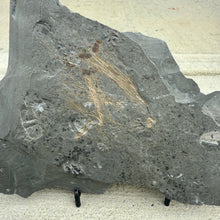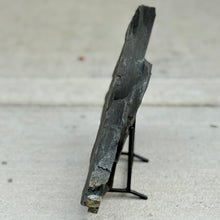
Very Rare and Excellently preserved fossilized Spicules from a Choia sponge found in the Wheeler shale Utah West Desert. Remnants of Utah Cambrian fossilized trilobite also present as well as trilobite imprints.
Age: Middle Cambrian (521 to 497 mya)
Species Name: Choia carteri
Order / Family: Protomonaxonida / Choiidae
Phylum: Porifera
Locality: Millard County, Utah
Size: Approximately 6 1/2" x 5 1/2", 1.37 lbs.
Comes with metal stand.
The preserved skeletal spicules are not connected in most fossilized Cambrian sponges that are found. They are usually separated after death of the animal and the beginning of soft tissue decay.
Characters of the sponge important for classification include skeletal composition and shape of skeletal spicules which are a small, needle-like anatomical structures that serve various functions... part of the skeleton, providing support and deterring predators, and are made of silica or calcium carbonate.
Sponges (Poriferans) are simple aquatic animals that attach to hard surfaces and feed and live by moving water through openings in the body wall. There are many forms of sponges varying in shape, size and if they are solitary or live in colonies. They exist in all water depths.
Choiidae is an extinct family of demosponges that lived from the Cambrian to the Lower Ordovician periods. These sponges somewhat resembled a pincushion, with siliceous spicules. They are known for their disc shape, covered with radiating spines, and are famous fossils from deposits found in Utah, Morocco, Canada and China.
Choia was originally thought to rest directly on the sea floor with radiating spines from the edge of it's flat, conical body and not attached to the seabed. Recently discovered fossils from Lower Ordovician Morocco show that the living animal was actually suspended high above the seafloor, attached via stalk-like spines derived from spicules.













